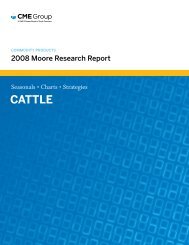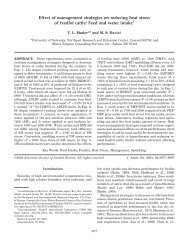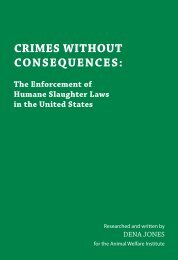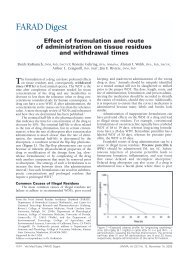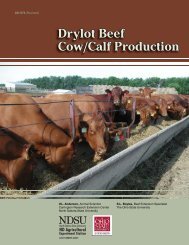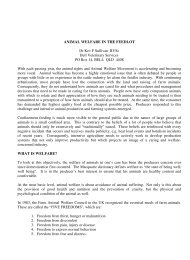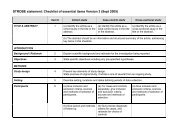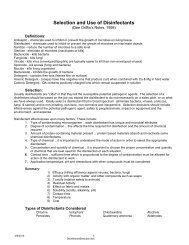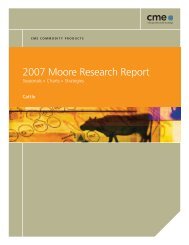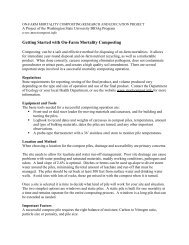Field Necropsy of Cattle and Diagnostic Sample Submission - gpvec
Field Necropsy of Cattle and Diagnostic Sample Submission - gpvec
Field Necropsy of Cattle and Diagnostic Sample Submission - gpvec
Create successful ePaper yourself
Turn your PDF publications into a flip-book with our unique Google optimized e-Paper software.
404<br />
Griffin<br />
Avoid overfilling liquid containers, don’t exceed one-half <strong>of</strong> the container capacity.<br />
Whirl-Pak (Uline, Pleasant Prairie, WI, USA) bags are superior to Ziploc bags;<br />
twist-tie the metal strip after closing.<br />
Tape all rubber-stoppered tubes.<br />
Double check for potential leakage <strong>of</strong> all containers.<br />
Place all specimens inside a large plastic bag that contains sufficient absorbent<br />
(cat litter or paper towels) for all the fluid in the containers to be shipped should<br />
they be damaged during shipment.<br />
Avoid breakable specimen containers . if used, pad <strong>and</strong> double bag the container.<br />
Place paperwork in waterpro<strong>of</strong> bag; Ziploc bags work best.<br />
If there are shipment questions, contact the carrier <strong>and</strong>/or laboratory.<br />
Packaging <strong>Diagnostic</strong> Specimens (Biologic Substances, Category B)<br />
<strong>Diagnostic</strong> specimens must be triple packed as follows:<br />
Primary container should be a screw cap tube, taped red top blood tube, or<br />
Whirl-Pak bag wrapped with the tie ends twisted together. Ziploc bags are not<br />
suitable for liquid primary containers. 9–12<br />
Secondary container must be water-tight <strong>and</strong> have sufficient absorbent, such as<br />
paper towels, should the primary container leak or rupture.<br />
Outer package (third layer <strong>of</strong> the specimen shipment container) should be at least<br />
as durable as sturdy cardboard. Although Styr<strong>of</strong>oam is an excellent container; it<br />
should never be used as a shipping container without residing in a sturdy cardboard<br />
box. Styr<strong>of</strong>oam coolers are not acceptable as the exclusive outer<br />
container because <strong>of</strong> the potential for rupture if dropped or impacted in a transportation<br />
accident.<br />
USPS limits less than 1 L (1 L) liquid per primary container with total <strong>of</strong> less than<br />
4 L or less than 4 kg solid per shipment. USPS requires a biohazard logo. Some<br />
carriers limit shipment to less than 0.5 L or less than 0.5 kg solids.<br />
Shipper’s <strong>and</strong> consignee’s contact information, including 24-hour telephone<br />
number, should be on the label (Fig. 17).<br />
Both a “Biologic Substance” label <strong>and</strong> a UN3373 diamond logo (see Fig. 16)<br />
should be on the outer shipping container.<br />
BOTTOM LINE<br />
<strong>Diagnostic</strong> specimens must be packaged in triple packaging consisting <strong>of</strong> 9–12 : (1) aprimary<br />
container, such as a screw-cap tube or plastic bag; (2) a secondary container<br />
that must be watertight <strong>and</strong> contain sufficient absorbent to capture any leakage; (3)<br />
outer packaging that is <strong>of</strong> sturdy cardboard (do not use Styr<strong>of</strong>oam coolers as the outer<br />
container); <strong>and</strong> (4) a properly labeled shipping container (see Fig. 17).<br />
Assume that specimens will travel in part by air, so meet International Air Transport<br />
Association shipping requirements (eg, 1 L <strong>of</strong> 10% formalin per properly packaged<br />
sample container, or 30 mL per sample container if it includes formaldehyde<br />
<strong>of</strong> >10% concentration). Shipping with dry ice has a few additional requirements<br />
(see Fig. 17). 12 The outer shipping container must be marked with “Carbon Dioxide,<br />
Solid or Dry Ice” <strong>and</strong> the UN Identification Number “UN1845” <strong>and</strong> a Class 9 label.<br />
REFERENCES<br />
1. Federal Food, Drug, <strong>and</strong> Cosmetic Act (FD&C Act), Section 402(a)(1) or (2), CPG Sec.<br />
675.400 Rendered Animal Feed Ingredients, Revised: 11/13/98. FDA, Washington,<br />
DC.




